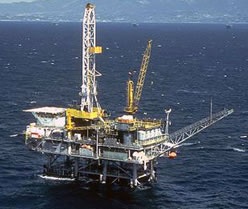- Home - News
- TWI News | TV
- Polls
- Year In Review
- News Archive
- Crime & Punishment
- Politics
- Regional
- Editorial
- Health
- Ghanaians Abroad
- Tabloid
- Africa
- Religion
- Election 2020
- Coronavirus
- News Videos | TV
- Photo Archives
- News Headlines
- Press Release
General News of Thursday, 19 July 2012
Source: radioxyzonline
Statement: Recent Media Discussions on GNPC and Jubilee Oil

In the past weeks, the media has published allegations about the Ghana National Petroleum Corporation attributed to senior public officials speaking on platforms organised by the Extractive Industries Transparency Initiative and STAR Ghana or to IMANI Ghana. The published allegations are that:
- 1. GNPC does not account to national authorities for the resources entrusted to our management including an amount of US$207.96 million ceded to GNPC in 2011.
- GNPC unilaterally appropriates public funds under our stewardship and has for example refused to pay dividends on its 2011 earnings.
- GNPC is misleading the public regarding Jubilee oil production prospects.
- The costs of the Jubilee field development and particularly the costs of the Jubilee Phase 1A remediation programme are far above comparable costs around the world and that Ghana is not getting value for money.
We wish to respond formally to these allegations and set minds at rest.
GNPC ACCOUNTABILITY TO PUBLIC AUTHORITIES
It is completely inaccurate to state that GNPC does not render accounts to the State for oil revenues. GNPC is in compliance with our statutory reporting and accountability obligations.
- GNPC is audited by the Auditor-General every year and our audited accounts are submitted to all relevant Government Agencies including the Ghana Revenue Authority (GRA) in accordance with Article 187 of the Constitution and Section 12 of the Ghana National Petroleum Law, 1983, (PNDC Law 64).
- GNPC submits its annual work programme to Parliament for review and approval as required by the Petroleum Revenue Management Act, 2011, (Act 815). Indeed it is Parliament that approves the allocation of a portion of revenues from Jubilee production to the corporation.
- GNPC has accounted to Parliament for its annual budget allocations from Jubilee revenue through the Ministry of Energy and Ministry of Finance and Economic Planning as required by the PRMA.
- GNPC regularly submits Financial Statements and Quarterly Reports on our operations to the Minister for Energy, Minister for Finance and the State Enterprises Commission.
- GNPC submits Daily Production Reports to the Minister for Energy, the Minister of Finance and Economic Planning, the Governor of the Bank of Ghana; the Commissioner-General, Ghana Revenue Authority, the Executive Secretary of the Energy Commission and the Chief Executive of the Petroleum Commission.
In 2011, Parliament allocated US$207.96 million from Petroleum Revenues to GNPC. During the 2012 budget hearings, GNPC accounted to Parliament through the Honourable Minister for Energy and the Honourable Minister for Finance and Economic Planning on the use of these funds as follows -
• US$132,484,815 million (or 63.7%) went to repay part of the money GNPC borrowed from the Jubilee partners to pay for our US$165.8 million share of field development costs incurred since 2008.
• US$30,315,185 (or 14.6%) went towards the acquisition, processing and interpretation of 2,612 km² of 3D Seismic Data for the Southwest Deep Tano block.
• US$28,119,624 (or 13.5%) was used in fabrication and installation of 14 km of deepwater pipeline as part of the Natural Gas Infrastructure Project;
• US$7,661,475 (or 3.7%) went to Staff costs.
• US$9,383,204 (or 4.5%) went towards General Operational and Administrative Expenditure.
These receipts and expenditures are captured in detail in our 2011 financial statements currently undergoing external audit. Our 2011 external audit is behind schedule because it took us some time to work through some of the accounting policy impacts of the 2011 Petroleum Revenue Management Act – and not because we are reluctant to account for these monies. Once the audit is concluded we will circulate our accounts as required by law.
GNPC DIVIDEND PAYMENTS
It is completely incorrect to allege that GNPC withholds revenue from the Government. This reflects a misunderstanding of the workings of the PRMA. The practice has been that GNPC does not directly retain any revenues from the participating interest in Jubilee production. Rather, GNPC hands over 100% of the gross revenues to the State. The State then cedes such funds as Parliament considers necessary to cover GNPC’s share of development and production costs, annual administrative costs and its long-term capital needs. GNPC therefore has no discretion over dividend payments since all the revenues are already fully under State control. The ceded funds are not subject to dividend payments because this would mean that GNPC would not have the resources required to execute the projects Parliament and the Executive would have approved.
JUBILEE PRODUCTION PROSPECTS
Contrary to IMANI’s pessimistic assessment, the Jubilee field operations have been competent. Jubilee has delivered industry-leading operational and safety performance. The field was brought on-stream in record time and within budget. It has a record of 98% uptime and has suffered no lost time incidents.
Production has been lower than originally projected. Both GNPC and Tullow the Operator have offered truthful public explanations for the decline in production and explained the remedial works underway to reverse this decline.
Also contrary to IMANI’s claims, the Jubilee team’s production projections for end-2012 and beyond are scientific and consistent with the results of the remedial works conducted so far and the pace of Phase 1A development. The Jubilee team has completed remedial work on three of the Phase 1 production wells and brought them back on-stream at increased rates and at reasonable costs. The Jubilee team plans to conduct similar remedial work on three more wells this year. The Jubilee team has also drilled two new Phase 1A production wells and one injection well. We will produce from these new wells in the last quarter of 2012.
In the first half of 2012, Jubilee produced an average of about 63,000 bopd. Jubilee is currently producing at the same average rate even though at any particular point in time one well is off-line undergoing remedial work. As these wells and the new Phase 1A wells are brought on-stream we expect Jubilee production to peak at 90,000 bopd by the end of the year and to achieve an annual average of between 70,000 and 80,000 bopd for 2012. We expect to ramp up to plateau production of 120,000 bopd in 2013.
JUBILEE FIELD DEVELOPMENT COSTS
IMANI alleges that the original Jubilee development costs are abnormally high. IMANI seeks to demonstrate this by comparing Jubilee costs to the costs of what they claim are comparable developments in Brazil and Angola. IMANI is misinformed. The comparisons they make are superficial and simply unscientific.
Development costs are not the same across time or place. For example, when oil prices are high, development activity increases and there is greater competition for equipment and services thus driving costs upward. When prices are low, activity falls and there is a lot more idle capacity available creating a buyers’ market. The Jubilee Field was developed between 2009 and 2011 when oil prices were at an all time high consistently exceeding US$70 per barrel and often above $100 per barrel for prolonged periods. Rig rates during this period ranged from US$440,000 – US$650,000/day with aggregate daily drilling costs (“spread rates”) around US$1 million per day. By contrast, Angola’s Girasol Field development commenced in July 1998 and Brazil’s Roncador was discovered in October 1996 with production commencing in 1999. In this period, oil prices averaged about US$20 per barrel and rig day-rates were about US$200,000 per day.
Further, development costs depend on the physical availability of oilfield equipment and services in the area of operations. Obviously, the further one has to transport equipment, materials and experts the higher the costs of the operation are likely to be. Again, Brazil and to a large extent Angola had mature oil and gas industries at the time Roncador and Girasol were developed. To a large extent equipment, materials and labour for these developments were available locally. By contrast, nearly everything and everyone had to be imported over long distances for the Jubilee development. Again the comparison is unreasonable. To use Girasol or Roncador as benchmarks for Jubilee is simply unprofessional.
After we had pointed out the flaws in the analysis they published on 5 July 2012 IMANI came back on Sunday 15 July, 2012 with fresh claims regarding the Jubilee Phase 1A development. IMANI says that their independent verification suggests that cost of Jubilee Phase 1A have been inflated by over 100%. Again IMANI puts forward a number of uninformed arguments to substantiate their claim. We will respond to these as follows -
- IMANI’s claims that the cost of drilling a well in water depths of less than 4,000 ft is US$220,000 per day is simply wrong. IMANI’s figure will at best cover only the “bare boat” cost of a drilling rig. It will not cover the “spread rate” which includes all the facilities, supplies and services without which a drilling rig is not of much use. These include mud logging, coring, cementing, Remote Operating Vehicles, support vessels, anchor-handling vessels, aviation support, communication support, supply base, freight and material handling, mud and chemicals, cement and additives, drill consumables, diesel fuel, wellhead equipment, tubulars and accessories, drill bits, completion consumables, supervision and administrative cost.
- IMANI’s assertion that Jubilee wells are located in water depths of 3609 ft is non-factual and indeed baseless. 3609 ft is simply the depth at which the FPSO Kwame Nkrumah is moored. The Jubilee Phase 1A wells are spread over several kilometers not just clustered around the FPSO. Water depths range from 3,600 ft to 5100 ft. If IMANI had checked their facts (instead of applying the FPSO mooring depth to all wells) they would have realized that the Jubilee Phase 1A project requires rigs rated for water depths of more than 4,000 ft. The bare boat rates for such rigs range between US$440,000 and US$650,000 and not the US$220,000 per day IMANI puts forward. Spread rates for these wells are around US$1.6 million during drilling operations. During well completion (installation of all the equipment required to produce the oil from the reservoir safely) the spread rate increases further.
- IMANI’s figure of US$122.5 million for the Technip subsea facilities contract is also wrong. It does not represent the entire subsea infrastructure cost. That figure covers only project management, engineering, fabrication and installation of one new flexible riser, two rigid flow lines, and 11 spools/jumpers, as well as the installation of two manifolds and 5 kilometres of umbilicals. It does not cover other necessary subsea components including Subsea Christmas trees, Pipeline End Termination (PLET), Connectors, Suction Piles, Umbilical Termination Assemblies (UTAs) and Multi-phase flow meters. All these add substantial cost to the project CAPEX.
- IMANI’s assertion that the 18-month project schedule (starting in March 2012) is inconsistent with a December 2012 First Oil date is wrong. The Jubilee Phase 1A project will not end with First Oil. First Oil will commence with only 5 out of 8 wells completed. The other 3 will be completed in 2013. This is a normal project management practice. IMANI’s analysis of Jubilee Phase 1A project cost is informed by wrong information and wrong extrapolation from inadequate information. They could have spared themselves and the public some anxiety by simply asking GNPC for the correct information and challenging us to explain before going public. Our doors are always open for constructive discussion about the oil and gas industry in Ghana.
We wish to assure the public that we take our responsibility to inform and engage with stakeholders very seriously. We understand that with the commencement of production, public demand for information and analysis about the sector has grown exponentially. We regularly respond to information and presentation requests from journalists and Civil Society Organisations (CSOs). We make presentations to Industry, Labour, communities and civil society. We supported this year’s New Year School as a platform for engaging a very wide spectrum of national opinion leaders. We participate actively in the Extractive Industries Transparency Initiative Committee through which information is available to civil society stakeholders and the Ghanaian public. As a national oil company, we see these engagements as central to our core mandate.
Issued by: Corporate Affairs Department
Ghana National Petroleum Corporation










